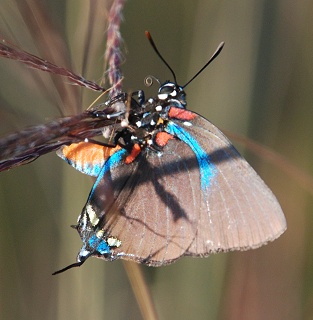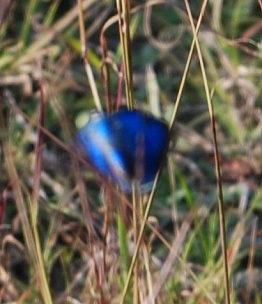Two years of drought followed by heavy rains in a warm fall has produced bursts of spring flowering and some spring butterflies even as it’s produced sudden fall color…a very odd combination.

This very fresh male Great Purple Hairstreak, Atlides halesus, flew nearby at knee level on November 10. We usually see them only in spring, when they’re one of the many butterflies all over flowering elbowbush and wild plum. But here he was, flashing the brilliant iridescent blue of his dorsal wing surface in short flights, and then posing demurely with wings closed, giving only tantalizing hints of the hidden beauty. The two apparent white spots on the hind wing are actually lime green, but I’ve never been able to get that color to show in the images. I was hoping, with such a fresh and vividly colored specimen, that it would–but once again it washed out.
I lacked the skill to catch a really good shot of this butterfly in flight, but did get one blurry shot of the dorsal wing surface that barely conveys the startling vividness of that blue.

I’ve also seen a few freshly-emerged Monarchs…flying north. I hope they get turned around, but if they aren’t in reproductive diapause, their little internal guidance center may be telling them the wrong thing. Our other butterflies are a mix of autumn-winter species and spring ones.
Flowering on the land at the moment is also a mix of spring and fall. Blackfoot Daisies will flower any time there’s rain and it’s warm enough–and the little mounds of white are widespread. Greenthread, usually found in spring only, is flowering. So is a tiny little blue vervain. Heath aster is variable but usually quits earlier than this; autumn aster is mostly gone. I saw one pink evening primrose on Tuesday’s walkabout–way out of season for that one. Lots of wild onion, but only the white ones–no Drummond wild onion (pink and purple.) Partridge pea is flowering over across the creek.
We did find some flood damage to the uppermost check dam on the secondary drainage, so when the field dries out enough to move some rock up there, we’ll do so. That check dam, built by our son, halted headward erosion originating from highway runoff and showed no damage for years–this is the first sign of a problem (and is why we check the dams and gabions after every flash flood.) Water outflanked the dam and tore through the grass on one side. Erosion control is one of the seven prescribed activities in our wildlife management plan and preventing erosion is always part of good water resource management.